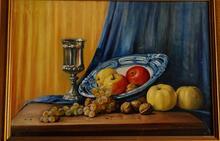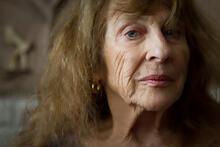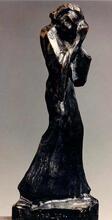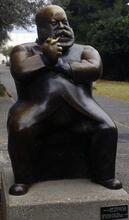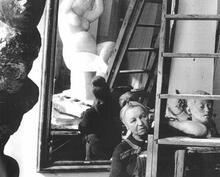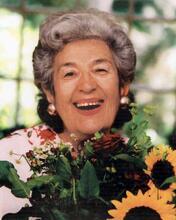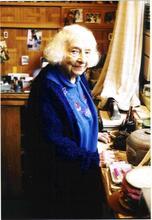Teresa Żarnower (Żarnoweröwna)
One of the most important artistic personalities of the Polish constructivist avant-garde in the 1920s, Teresa Żarnower founded the first Polish constructivist artistic group, “Blok,” and also edited the magazine of the same title. In 1923 she took part in the Exhibition of New Art in Vilna, which was the first constructivist manifestation in Poland. In 1927 she collaborated with a left-wing magazine Dźwignia (The Lever) and became engaged more intensively in left-wing politics. She took part in the electoral campaign for parliament, supporting Workers and Peasants Unity, for which she designed the election poster and two-party leaflets. In 1942 she created a cycle of photo-montages The Defense of Warsaw and later worked on a monumental sculpture devoted to the Warsaw Ghetto uprising.
One of the most important artistic personalities of the Polish constructivist avant-garde in the 1920s, Teresa Żarnower was a thoroughly educated person with wide interests. She was close to Mieczysław Szczuka (1898–1927) together with whom she founded the first Polish constructivist artistic group, “Blok,” and also edited the magazine of the same title. Although Szczuka always stressed the importance of Teresa Żarnower’s artistic and intellectual contribution to their common activities, she was most often regarded by art historians as overshadowed by this eminent artist.
Early Life and Family
Teresa Żarnower was born in Warsaw in 1895 into a Polonized Jewish family. She began her art studies in 1915 at the Szkoła Sztuk Pięknych (Fine Arts School) in Warsaw, in sculpture class given by Professor Edward Wittig (1879–1941). Here she made her first important contacts: with Henryk Stażewski (1894–1988), Maria Nicz Borowiakowa (1896–1944), artists who in the inter-war period constituted the core of the Polish constructivist avant-garde, and Mieczysław Szczuka, who in the years that followed became her partner in both art and life. In 1920 her diploma work Akt won a prize in a sculpture competition organised by the Ministry of Art and Culture. In 1921, she made her debut in the Spring Salon of the Towarzystwo Zachęty Sztuk Pięknych (Society for Fine Arts Promotion) in Warsaw. It is difficult to discuss her early work, since most of it was lost or destroyed. However, reproductions as well as propaganda material and other publications she created are a source of information about her early work. Some of the theoretical texts and magazines for which she co-designed the graphic layout are also extant. We know that she began by creating sculptures, abstract works of geometrical shape. In 1923 she took part in Wystawa Nowej Sztuki (Exhibition of New Art) in Wilno (Vilna), which was the first constructivist manifestation in Poland. Her programmatic text, which can be found in the exhibition catalog, contains a number of basic principles for artistic creation: simplicity and logic of the work of art, use of new materials and utilitarian possibilities, and perfection of techniques. The manifesto, which touched on the problems of modern civilization, technology, and integration of the arts, was presented by Teresa Żarnower in her own typographic layout. In the same year she participated, together with Szczuka, in the exhibition organized by Herwarth Walden (1878–1941) in the Berlin gallery “Der Sturm”.
Exhibitions and “Blok”
Numerous meetings and discussions between young constructivists in Teresa Żarnower’s apartment in Leszno (in Warsaw) resulted in the founding, in 1924, of the first organization in Poland that brought together the artists of this school. According to Szczuka it was Teresa Żarnower who proposed the notion of “Grupa Kubistów, Konstruktywistów i Suprematystów Blok” (Cubists, Constructivists and Suprematists group Blok). Szczuka also ascribed to her the idea of publishing a magazine—a press organ for the group. In this period Teresa Żarnower gave up sculpture and created rigorous geometrical abstract compositions, strengthening her convictions regarding the need to link artistic questions with utilitarian functions by creating typographic designs and scenographic and architectonic projects. She presented her works twice at “Blok” exhibitions, first in Automobile Salon Laurin-Clement in Warsaw in 1924, and then in the Artists Club at the Polonia Hotel at the turn of 1924/25. Together with Szczuka she edited Blok, Czasopismo Awangardy Artystycznej (Blok, The Magazine of Artistic Avant-garde). At first, two additional artists were members of the editorial board but following differences of opinion in the group Szczuka and Teresa Żarnower worked together alone. The “Blok” typography was very innovative: the graphic layout was distinguished by its simplicity and economy of means, consisting only of various letter types and simple signs. The basic postulate followed was uniting the form and content of the published texts into an integrated whole. Misunderstandings, differences of opinion and increasing domination by Szczuka and Teresa Żarnower, who were trying to impose their views about the utilitarian purpose of artistic activities, led to the group’s final disbanding in 1926. The unequivocal character of Żarnower’s views was confirmed by the presentations and exhibitions in which she took part. In 1926, in addition to an International Exhibition of Modern Art in Bucharest, she participated in the first International Modern Architecture Exhibition in Warsaw, where she showed her projects of modern co-operative blocks of apartments, prepared together with Szczuka. A year later she took part in the Modern Architecture Exhibition in Moscow. From 1927 she collaborated with a left-wing magazine Dźwignia (The Lever), edited by Szczuka, in which she presented her house and garden projects, prepared together with him. In 1929 she designed the cover for Ilya Erenburg’s (1891–1967) 4 fajki, which was an unusually simple and coherent composition. In 1927 she prepared the layout for an edition of selected poetry by Vladimir Majakowski (1893–1930).
In 1927 Szczuka met a tragic death during an excursion in the Tatra Mountains. Though Teresa Żarnower was profoundly depressed, she devoted the ensuing months to finishing the projects he had started, including the edition of Anatol Stern’s (1899–1968) poem Europa, for which she designed the cover, using the photo-montage technique (1929). She published two further editions of Dźwignia, following the directions outlined by Szczuka but adding her own elements to the graphic design.
Political Involvement
At the end of the1920s she engaged more intensively in left-wing politics. Her brother David, a doctor and an active member of the Communist Party of Poland (KPP), was probably the major influence in this respect. She took part in the electoral campaign for parliament, supporting a left-wing organization, Workers and Peasants Unity (Jedności Robotniczo-Chłopskiej), for which she designed the election poster and two party leaflets, using the constructivists’ avant-garde approach and connecting it with the photo-montage technique. She also designed the graphic layout of a number of magazines: Kuźnia, Miesięcznik młodzieży robotniczej (The Forge, a Worker Youth Monthly) (1927), Miesięcznik Literacki (Literary Monthly) (1929) and in 1931 Czerwony Sztandar (The Red Banner)—the publication of the Central Committee of the Polish Communist International section. In 1931 she signed the manifesto against torture of political prisoners. Later she ceased her artistic activities. In 1937 she left Poland to live in Paris, Spain, Portugal, Canada and the USA. Influenced by news from Europe, she returned to art during World War II, while living in New York. In 1942 she created a cycle of photo-montages The Defense of Warsaw and later worked on a monumental sculpture devoted to the Warsaw Ghetto uprising. Throughout these years she returned to sculpture and planned an exhibition, despite the deep depression caused by the war and the fear that all her relatives had been killed. She died suddenly, soon after receiving a letter from her brother, who wrote that he had survived and was in Russia. At her side in her New York flat a letter was found, of which she had managed to write only one sentence: “The joy that you are alive will probably kill me...”
Teresa Żarnower, who was a pioneer in many fields of art, belonged to the strict avant-garde of the inter-war period. Her Jewish origin seems to have played no part in her work. However, her contacts with other Jewish artists, such as Henryk Berlewi (1894–1967), an outstanding representative of Polish constructivism, were of some importance. Such contacts were significant, since the Jewish artistic milieu played an important role both in adapting the achievements of world art in Poland and in the promotion of constructivism.
Stern A., and Berman M., Mieczysław Szczuka (Polish). Warsaw: 1965.
Druk funkcjonalny (exh. cat.). Museum of Art, Łódź: 1975. (Polish).
Baranowicz, Z. Polish artistic avant-garde 1918–1939 (exh. cat.). Warsaw: 1979. (Polish).
70th anniversary of the Exhibition of Modern Art (exh. cat.). Museum of Art, Łódź :1993. (Polish and English).
Turowski, A. Polish constructivism. Attempt of reconstruction (1921–1934). Wrocław: 1981. (Polish).
Constructivism in Poland 1923 to 1936 (exh. cat.). Museum of Art, Łódź and Centre Georges Pompidou, Paris: 1983.
Turowski, A. Constrictors of the world: From the history of radical modernism in Poland (Polish). Krakow: 2000.

